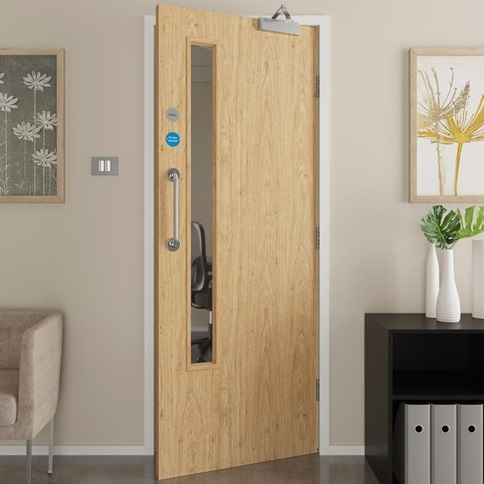Use our FREE downloadable Fire Door Inspection Checklist to ensure your fire door is in working order
One of the most effective ways to prevent the spread of fire and smoke in any building is by installing fire doors. This is a great form of passive fire protection. However, if not appropriately maintained, they could be a hazard. It is essential to complete regular fire door maintenance. Read on to learn more about the importance of maintaining fire doors and what laws buildings must follow.
Why Have a Fire Door in Your Building?
For most buildings, having a fire door is a requirement. However, they offer benefits that make them desirable options regardless of the law.A fire can happen in any place at any moment. With the help of a fire door, the spread of fire and smoke slows down. Not only does this save lives, but it can save a building from costly damage.

Why Is Fire Door Maintenance Important?
Installing fire doors is not enough to keep up with safety protocols. After installation is complete, doors have to be regularly maintained to ensure proper functioning. Every element of the fire door system must undergo inspection, not just the door itself. Latches, framing, hinges, handles, and locks are also maintained. This even includes the intumescent strips. These strips play a significant part in preventing the spread of fire.Every fire door has a minimum fire resistance time of 30 minutes. Intumescent strips themselves are activated by heat, the material swells to create a seal, filling the gap between the door and the door frame. Even the smallest disruption in the state of the door can affect its performance. Periodic checks by certified specialists should always stay up to date for safety and to follow regulations.
Regular Inspections
Regular internal fire door maintenance should be completed at least twice a year or annually at the very minimum. In fact, in most areas, this is mandatory for buildings. Companies that offer fire door installation and maintenance may suggest monthly fire door inspections. For a fair price, this is worth looking into. The inspection process:
- Checking that door frames, leaves, and hardware uphold their required fire-resistance rating.
- Checking that door openers function appropriately. Self-closing and self-latching openers must be fully operational.
- Ensuring doors have not been fitted with a deadbolt or something similar since the previous inspection.
- Checking that all edge clearances have no alterations and continue to stay compliant with regulations. You must always ensure that the doors are not broken, split, damaged, misaligned or altered in any way. These factors can majorly impact how the doors stop a fire, gases, or smoke.
Signage
To stay compliant with fire door regulations, it is essential to have the correct signage. When a professional completes an inspection, they will also check for appropriate signage. Correct signage includes labelling a door as a fire-rated door or fire exit, among other things. You may benefit from labelling safety equipment to make things easier during an emergency.
Between Inspections
Annual inspections are necessary, but sometimes you need more than a check every year. You do not need to wait for your inspection date to complete maintenance for fire doors. Instead, keep an eye out for any damage that might occur between inspections.
Upon noticing anything unusual, contact someone to repair or replace the door as soon as possible. Even something as small as a missing screw must be noted. Contact a fire door maintenance service to help you fix the problem. It is important to note that professionals can’t fix or replace a door if the fire alarm system in the building is not operational. You should also lookout for any obstacle that could be obstructing doors in any way. Should you find that your current fire door is not up to standard, it is extremely important that you book a repair service.Always inform your staff of the dangers of placing something in front of a fire door to ensure it doesn’t happen again. If you run a rental property, try your best to explain fire offences to the occupants. Occupants might not understand fire regulations, so it is your job to keep them compliant with the law.
New Building Approved Documents
New buildings must follow building regulations known as ‘Approved Documents’. This document was put together to standardise the elements of a door’s features and structure. Approved Document B is the most relevant document, as it focuses on fire safety. It states precisely how long the fire resistance needs to be, where the door should be fitted, and which signage is required. Other relevant and essential Approved Documents include:
- Approved Document E: Resistance to Sound
- Approved Document F: Ventilation
- Approved Document L: Conservation of Fuel and Power
- Approved Document M: Access to and Use of Buildings
- Approved Document N: Glazing Safety
The Regulatory Reform Act replaced a lot of aspects of fire safety law. However, different fire door regulations exist for fire doors in existing and new buildings.
Is Your Building Up-to-Date on Fire Door Maintenance?
Building codes are required for safety reasons and fire doors are no exception. Installing fire doors in your building is not enough to stay up to date on safety regulations, you also need regular fire door maintenance.Whether you need fire door installation or maintenance, ClearView is here to help. Our accredited and certified company will ensure that fire doors are installed correctly and checked regularly as per the guidelines. Contact us now for all of your fire door installation and maintenance needs.